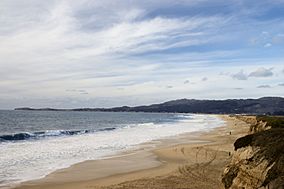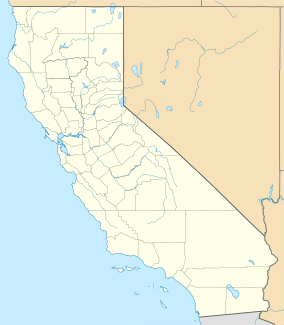Half Moon Bay State Beach facts for kids
Quick facts for kids Half Moon Bay State Beach |
|
|---|---|

Half Moon Bay State Beach
|
|
| Location | San Mateo County, California, USA |
| Nearest city | Half Moon Bay, California |
| Area | 181 acres (73 ha) |
| Established | 1956 |
| Governing body | California Department of Parks and Recreation |
Half Moon Bay State Beach is a beautiful stretch of protected beaches in California, United States. It covers about 4 miles (6.4 km) along Half Moon Bay. This state park includes four main beaches: Roosevelt, Dunes, Venice, and Francis Beaches. The park was created in 1956 and covers 181 acres (73 ha).
Contents
Fun Things to Do at Half Moon Bay State Beach
The wide, sandy beaches are perfect for many activities. You can enjoy sunbathing, fishing, and having picnics with your family and friends.
Camping at Francis Beach
If you want to stay longer, there's a campground at Francis Beach. It has 52 spots for tents or recreational vehicles. While there are no hookups for RVs, there is a place to dump waste.
Surfing and Ocean Waves
This beach is located south of Pillar Point Harbor. It's a popular spot for surfers. The waves here are special because they are affected by the harbor's jetty. North of the bay, there's a county park with a great trail. Hikers and bikers can use this trail to reach the ocean below Pillar Point. Some of the biggest waves in California happen offshore of Pillar Point after large storms. This area is famous for a surfing spot called Mavericks, which hosts the annual Mavericks Surf Contest.
History of Half Moon Bay State Beach
For thousands of years, the Ohlone people, who were Native Americans, lived along the coast of San Mateo County. They lived in small villages. Their way of life changed quickly when the first Europeans arrived in the late 1700s.
Early European Visitors
The first European explorers in Alta California were part of the Portolà expedition from Spain. They camped near the beach on October 28–29, 1769. A missionary named Juan Crespi wrote in his diary about nearby Pillar Point. He said the high rocks looked like "two thick Farallones" (rocky islands).
Ranchos and New Settlements
After the Mission San Francisco de Asís (also known as "Mission Dolores") was founded in 1776, the San Mateo coast was used for grazing mission animals. In 1834, the mission lands were divided into large areas called ranchos. Raising cattle was the main activity, and trading hides and tallow (animal fat) was important. The beach south of Pilarcitos Creek was part of Rancho Miramontes. North of the creek was Rancho Corral de Tierra.
The first Americans arrived in the 1850s. They called the Mexican settlement "Halfmoon" because of the bay's shape. In 1867, the local post office was named "Halfmoon Bay," and the spelling changed to Half Moon Bay in 1905. By the early 1900s, farming grew in Half Moon Bay. Farmers grew crops like brussels sprouts, artichokes, and mushrooms. The Ocean Shore Railroad started running along the coast from Half Moon Bay to San Francisco by 1908.
World War II
During World War II, the Army set up a post at the beach. This was to protect the area from possible attacks.
Amazing Wildlife at Half Moon Bay
Half Moon Bay State Beach is known for its rare western snowy plover colony, a special bird species.
Marine Animals
Many types of fish live in the ocean here. Some common fish include flatfish, sole, rockfish, surfperch, and Pacific herring. In winter, you might see starry flounder and smelts.
You can also spot many marine mammals:
- California sea lion
- Steller sea lion
- Harbor seal
- Northern fur seal
- Elephant seal
- Dolphin
- Gray whale
- Humpback whale
- Blue whale
Land Animals
On land, you might see these animals:
- Raccoon
- California vole
- European rabbit
- Skunk
- Opossum
- Long-tailed weasel
- Gray fox
- Coyote
- Mule deer
- Mountain lion
Birds
Many different birds visit or live at the beach:
- Hen harrier
- Great blue heron
- Kestrel
- White-tailed kite
- Red-tailed hawk
- Killdeer
- Sandpiper
- Sanderling
- Willet
- Turnstone
- Curlew
- Pelican
- Sooty shearwater
- Gull
- Barn swallow
- Western snowy plover
Plant Life at Half Moon Bay
The area around Half Moon Bay State Beach is home to many interesting plants:
- Beach primrose
- Beach aster
- Blue blossom
- Brass buttons
- Cheese weed
- Chickweed
- Coyote bush
- Daisy
- Gumplant
- Coast hedge-nettle
- Poison hemlock
- Douglas iris
- Miner's lettuce
- Live-forever
- Lizard tail
- Coast lotus
- Coastal bush lupin
- Varicolored lupine
- Mallow
- Wild mustard
- Yellow oxalis
- Indian paintbrush
- Beach pea
- California poppy
- Wild radish
- Sagewort
- Sea fig
- Yellow sand verbena
- Sea-rocket
- Spilt-milk thistle
- Lotus trefoil
- Vetch
- Wallflower
- Watercress
Images for kids







